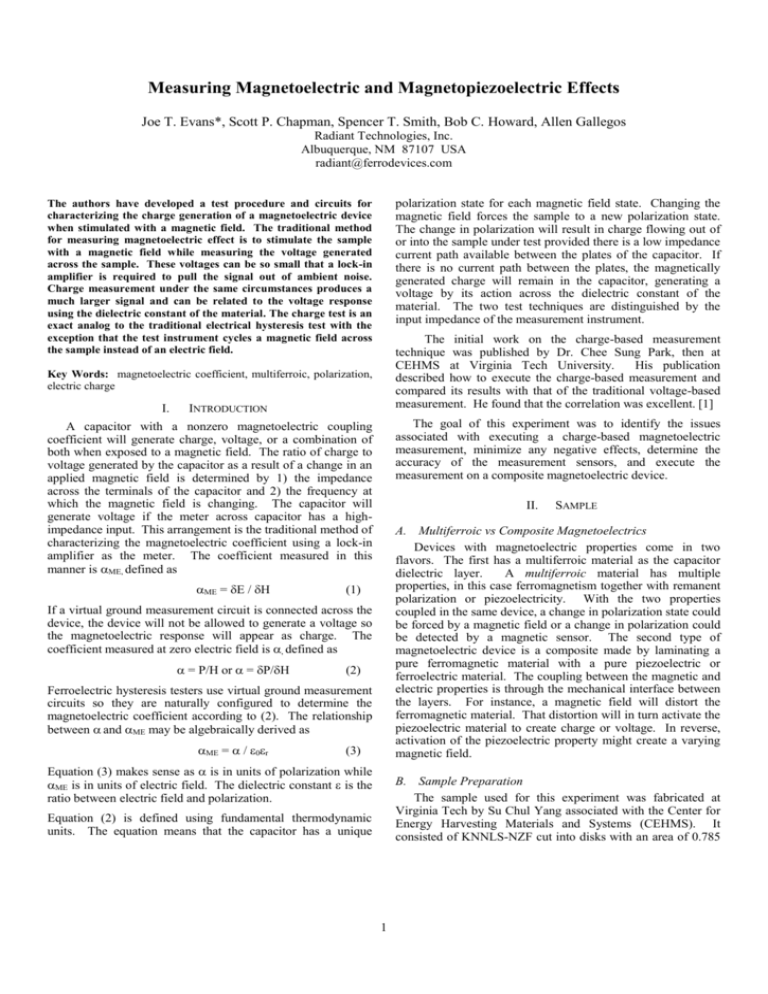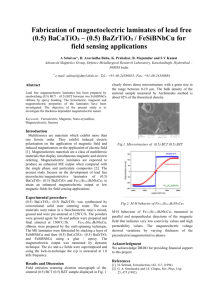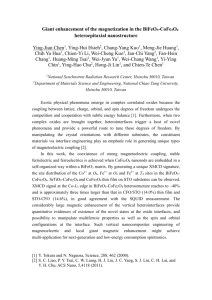D. Measuring the Magnetic Field
advertisement

Measuring Magnetoelectric and Magnetopiezoelectric Effects Joe T. Evans*, Scott P. Chapman, Spencer T. Smith, Bob C. Howard, Allen Gallegos Radiant Technologies, Inc. Albuquerque, NM 87107 USA radiant@ferrodevices.com polarization state for each magnetic field state. Changing the magnetic field forces the sample to a new polarization state. The change in polarization will result in charge flowing out of or into the sample under test provided there is a low impedance current path available between the plates of the capacitor. If there is no current path between the plates, the magnetically generated charge will remain in the capacitor, generating a voltage by its action across the dielectric constant of the material. The two test techniques are distinguished by the input impedance of the measurement instrument. The authors have developed a test procedure and circuits for characterizing the charge generation of a magnetoelectric device when stimulated with a magnetic field. The traditional method for measuring magnetoelectric effect is to stimulate the sample with a magnetic field while measuring the voltage generated across the sample. These voltages can be so small that a lock-in amplifier is required to pull the signal out of ambient noise. Charge measurement under the same circumstances produces a much larger signal and can be related to the voltage response using the dielectric constant of the material. The charge test is an exact analog to the traditional electrical hysteresis test with the exception that the test instrument cycles a magnetic field across the sample instead of an electric field. The initial work on the charge-based measurement technique was published by Dr. Chee Sung Park, then at CEHMS at Virginia Tech University. His publication described how to execute the charge-based measurement and compared its results with that of the traditional voltage-based measurement. He found that the correlation was excellent. [1] Key Words: magnetoelectric coefficient, multiferroic, polarization, electric charge I. INTRODUCTION The goal of this experiment was to identify the issues associated with executing a charge-based magnetoelectric measurement, minimize any negative effects, determine the accuracy of the measurement sensors, and execute the measurement on a composite magnetoelectric device. A capacitor with a nonzero magnetoelectric coupling coefficient will generate charge, voltage, or a combination of both when exposed to a magnetic field. The ratio of charge to voltage generated by the capacitor as a result of a change in an applied magnetic field is determined by 1) the impedance across the terminals of the capacitor and 2) the frequency at which the magnetic field is changing. The capacitor will generate voltage if the meter across capacitor has a highimpedance input. This arrangement is the traditional method of characterizing the magnetoelectric coefficient using a lock-in amplifier as the meter. The coefficient measured in this manner is ME, defined as ME = E / H II. A. Multiferroic vs Composite Magnetoelectrics Devices with magnetoelectric properties come in two flavors. The first has a multiferroic material as the capacitor dielectric layer. A multiferroic material has multiple properties, in this case ferromagnetism together with remanent polarization or piezoelectricity. With the two properties coupled in the same device, a change in polarization state could be forced by a magnetic field or a change in polarization could be detected by a magnetic sensor. The second type of magnetoelectric device is a composite made by laminating a pure ferromagnetic material with a pure piezoelectric or ferroelectric material. The coupling between the magnetic and electric properties is through the mechanical interface between the layers. For instance, a magnetic field will distort the ferromagnetic material. That distortion will in turn activate the piezoelectric material to create charge or voltage. In reverse, activation of the piezoelectric property might create a varying magnetic field. (1) If a virtual ground measurement circuit is connected across the device, the device will not be allowed to generate a voltage so the magnetoelectric response will appear as charge. The coefficient measured at zero electric field is , defined as = P/H or = P/H (2) Ferroelectric hysteresis testers use virtual ground measurement circuits so they are naturally configured to determine the magnetoelectric coefficient according to (2). The relationship between and ME may be algebraically derived as ME = / 0r SAMPLE (3) Equation (3) makes sense as is in units of polarization while ME is in units of electric field. The dielectric constant is the ratio between electric field and polarization. B. Sample Preparation The sample used for this experiment was fabricated at Virginia Tech by Su Chul Yang associated with the Center for Energy Harvesting Materials and Systems (CEHMS). It consisted of KNNLS-NZF cut into disks with an area of 0.785 Equation (2) is defined using fundamental thermodynamic units. The equation means that the capacitor has a unique 1 cm2 and a thickness of 0.5 mm. The disks were laminated to a nickel foil. The maximum response for this sample occurred at 460 Oersted: 12.5mV/cm/Oe. At 25 Oersted, the sample generated an ME response of 1.25mV/cm/Oe [2] determined by CEHMS using the voltage measurement technique. III. D. Measuring the Magnetic Field Due to the presence of the electrical shield box, a Hall Effect sensor could not be placed in the vicinity of the sample to collect magnetic field strength during stimulus. The authors used a high speed current sensor in line with the Helmholtz coil to determine the magnetic field at the sample while in the central cylinder of uniformity of the Helmholtz coil. Comparison of the current sensor to a calibrated gaussmeter indicated an accuracy of 97.5% for the current sensor at 1 Hz. TEST CONFIGURATION The charge-based magnetoelectric response test is executed by substituting a magnetic waveform for the traditional voltage stimulus in a polarization hysteresis test. The substitution is accomplished by placing a current source on the voltage output of the hysteresis tester to drive a Helmholtz coil. The sample is placed inside the coil at the center of the coil. Either a current sensor in line with the Helmholtz coil or a Hall Effect sensor placed at the sample location captures the magnetic field during the stimulus waveform. E. DC Field Bias Many magnetoelectric devices exhibit higher coefficients when exposed to a DC magnetic bias field during stimulation. A uniform DC bias field can be achieved by placing the sample and the Helmholtz coil at the center of a much larger field coil driven by its own high power amplifier. A non-uniform bias can be applied with a permanent magnet set next to the Helmholtz coil as in Fig. 1. No bias was applied to the sample for this experiment. Magnetoelectric measurement conducted in this manner is subject to a variety of limitations and parasitics. A. Frequency Limitations The inductance of the Helmholtz coil limits the maximum frequency that may be applied to the sample. VCoil = L I/t F. Small Signal Capacitance The mathematical steps to convert the coefficient to the ME coefficient require the use of the small signal capacitance of the device under test. Dividing the magnetoelectric charge measured under zero impedance by the sample’s small signal capacitance should predict the voltage the sample would generate under open circuit conditions. Most magnetoelectric devices vary their small signal capacitance as a function of magnetic field. The composite device under test exhibited a 1% variance in its small signal capacitance as a DC magnetic field varied over ±50 gauss. The small signal capacitance as a function of magnetic field is measured by executing the classic small signal capacitance electrical test on the sample as it rests inside the Helmholtz coil while the coil generates DC values of the fields to be used in the test. (4) The voltage limit of the current amplifier used by the authors in Fig. 1 becomes Vcoil in (4). Combined with inductance L of the coil, it limited the maximum frequency to 20 Hz. Distortion of the stimulus waveform sets in at frequencies below the limit, the reason why 1 Hz was used as the test frequency for this experiment. B. Charge Loss The most sensitive charge measurement requires an electrometer for the RETURN channel in Fig. 1. Electrometers leak and this leakage limits the minimum frequency at which the test may be run. The Radiant Technologies Precision Multiferroic nonlinear materials tester used for the experiment in Fig. 1 was characterized for charge loss by executing a traditional voltage-driven hysteresis test on a precision 10pF reference capacitor. At one volt, the capacitor should generate 10pC of charge plus or minus the precision of the reference capacitor, in this case a NIST-traceable 0.1% quality standard. The tester retained 99% of the charge during a 10 Hz test and 98.1% of the charge during a 1 Hz test. G. Parasitic Cable Capacitance A major advantage of the charge-based measurement approach is the use of the virtual ground across the sample. With zero volts across the coaxial cables connecting the sample to the tester, the parasitic capacitance of the cable cannot affect the test. The same is not true for the volt-based measurement using a lock-in amplifier. The charge generated by the sample is spread across the capacitance of the cables and the input of the lock-in amplifier, reducing the value of the measured voltage from the value the sample would generate if it were truly isolated. This parasitic effect for the voltage-based measurement must be measured and subtracted. C. Ambient Electric Noise The charge measured during the experiment was so small it was easily swamped by ambient electric noise in the room. Polarization hysteresis systems measure absolute charge so ambient noise cannot be eliminated by lock-in techniques. The ambient noise was eliminated by placing the sample inside an aluminum electrical shield box grounded to the tester. The box fit inside the Helmholtz coil and coaxial cables were used to connect the sample inside the shield box to the tester. H. Induced Charge The cables connecting the sample to the test must intrude inside the AC magnetic field generated by the Helmholtz coil. The AC magnetic field will induce current in the cables as the field varies amplitude. However, the magnetic field commanded in the Helmholtz coil by the polarization tester moves in steps, stopping at intermediate magnetic field levels to allow the sample to stabilize and for the tester to measure the total amount of charge captured from or given to the sample at 2 that point in the waveform. Because each charge measurement is made with the magnetic field in a static condition, there will be no magnetically-induced charge included in the measured charge. The voltage-based measurement is a dynamic measurement so induced charge will be added to the sample response and must be subtracted from the result. Dividing (6) by the area of the sample results in the equation that calculates the coefficient of the sample at the specified magnetic field. P/H = 0.00255h-0.00408 pC/cm2/Oe At 25 Oe, equals 0.06 pC/cm2/Oe. The ME coefficient is calculated from (6), not (7), by dividing that charge prediction by the small signal capacitance of the sample at the magnetic field strength of interest (758pF) to convert to units of volts. That result is divided by the sample thickness (0.5mm) to convert to electric field. I. Parasitic Charge As mentioned earlier in the section about parasitic cable capacitance, the test fixture contributes no parasitic charge to the results when a virtual ground instrument is used. Parasitic charge does arise from inside the polarization tester itself. This parasitic charge can easily be measured by simply disconnecting the tester from the sample and running the same test. ME = 5.28x10-5 h - 8.44x10-5 mV/cm/Oe (8) At 25 Oe, ME is predicted to be 1.24mV/cm/Oe. J. Voltage Bias It is possible with the test configuration used for this experiment to apply a voltage bias to the sample during magnetic field AC actuation. That was not done for this experiment. The sample electrodes were shorted with ground referenced on one plate and the polarization tester virtual ground input on the other. IV. (7) ANALYSIS The error in the charge measurement consists of the 0.5% specification provided by the manufacturer for the Precision Multiferroic tester used in the test plus the charge leakage from its electrometer circuit, measured at 1.9%. Thus, the charge measurement error for this experiment extended from -2.4% to +0.5%. The magnetic field measurement error was measured to be ±2.5%. The coefficient is found by dividing the charge by the magnetic field. Using the maximum charge uncertainty against the minimum magnetic uncertainty and vice versa yields a maximum error range of +3.1% to -4.8%. Therefore there is a reasonable expectation that the value of 0.06pC/cm2/Oe and the ME of 1.24mV/cm/Oe calculated for this sample at 25 Oersted are accurate to within ±5%. RESULTS A single test was run on the sample over ±25 Oe. The measurement was made with and without the sample in place in order to capture the parasitic charge generated by the polarization tester. Both measurements are plotted against each other in Fig. 2. The ME value measured by Su Chul Yang at Virginia Tech for this sample at 25 Oe was 1.25 mV/cm/Oe, a difference of 1% from that measured above. This is an excellent correlation but more work remains to be done. The next step in our research will be for the authors to work with CEHMS at Virginia Tech to perform the same error source evaluation on the traditional voltage-based method that measures ME and then comparing the two test techniques on a single knowngood sample. Subtracting the parasitic induced charge from the measurement should yield values close to the true magnetoelectric charge generation of the sample. The difference can be fitted with a polynomial equation which can then be used to predict 1) the charge the sample will generate at any H-field, 2) the value of for the sample at a specific Hfield, and 3) the value of ME at a specific H-field. The difference between the sample response and the induced charge is plotted in Fig. 3 along with its polynomial fit. Also shown in the plot is the equation of the fit. Since the charge plotted in Fig. 3 is an absolute response of the sample to the applied magnetic field, its coefficient at each magnetic field value is the slope of the polarization generated at that field. The charge generation result in Fig. 3 was fit with a polynomial resulting in (5) having an R2 value of 0.9767. ACKNOWLEDGMENT The authors wish to acknowledge the invaluable assistance of Dr. Shashank Priya, Su Chul Yang, and Shashaank Gupta from CEHMS at Virginia Tech. REFERENCES Q = 0.001h2 - 0.0032h + 0.0084 pC(Oe) (5) [1] The derivative of (5) gives the equation that calculates the slope of the charge response in Fig. 3 at a specified magnetic field. Q/H = 0.002h - 0.0032 pC/Oe [2] (6) 3 C. S. Park, J. Evans, and S. Priya, “Quantitative understanding of the elastic coupling in magnetoelectric laminate composites through the nonlinear polarization-magnetic (P-H) response,” Smart Mater. Struct., vol. 20, 6pp., 2011. Sample synthesized by Su Chul Yang of the Center for Energy Harvesting Material and Systems. All data rights are retained by CEHMS. Figure 1: Magnetoelectric test configuration. 4 Figure 2: Magnetoelectric charge response of the CEHMS composite laminated sample plus parasitic charge. 5 Q/H Figure 3: The true magnetoelectric charge response of the CEHMS composite laminated sample plus polynomial fit. 6






